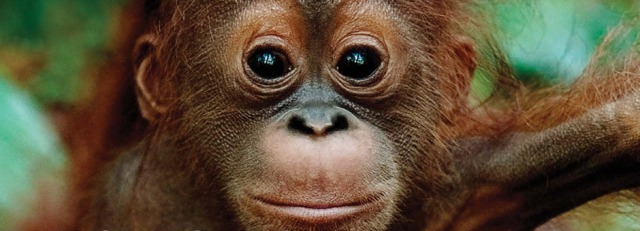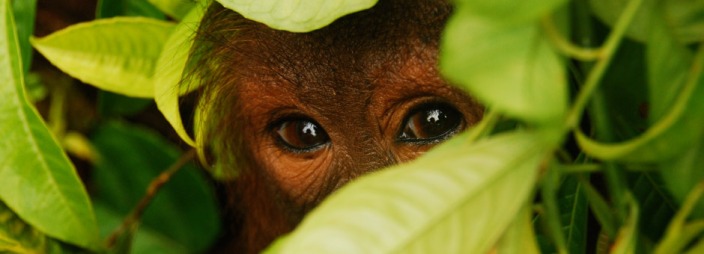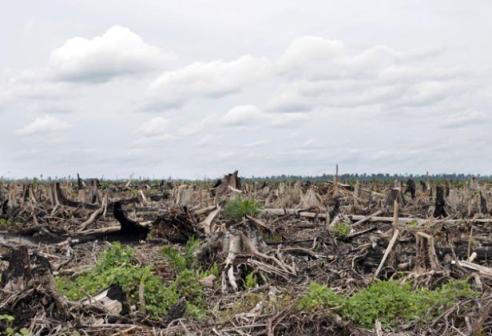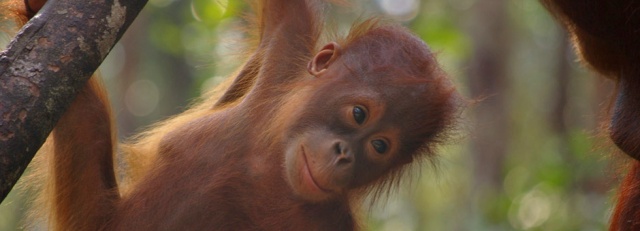Orangutans are known to be highly intelligent creatures – they share 96.4% of human genes. Orangutans, with their distinctive red fur, are the largest arboreal mammal and spend most of their time in trees. Orangutans play a crucial role in seed dispersal in their tropical forests. They have a very low reproduction rate, which makes their populations extremely vulnerable. Females give birth to one baby at a time every 3 to 5 years. Therefore their species take a very long time to regenerate after population declines. As human pressures continue to increase, orangutans face an increasing threat of extinction.

A baby orangutan. Photograph courtesy of http://www.orangutan.org
“Orangutan” means “man of the forest” in the Malay language. They live solitary existences in lowland forests. There are two species of orangutan: the Sumatran and the Bornean. The two species differ slightly in behaviour and appearance, with both having shaggy red fur, but the Sumatran orangutans have longer facial hair, and Borneans reportedly have closer social bonds. Both these species have experienced dramatic population declines. There were over 230 000 orangutans in the world a century ago, but today the number of Bornean orangutans is estimated to be at about 41 000 (enlisted as Endangered), and the Sumatran orangutans at about 7 5000 (enlisted as Critically Endangered).

The highly intelligent, piercing eyes of an orangutan. Photograph courtesy of http://www.orangutan.org
The orangutan is Asia’s only great ape. Their habitats are rapidly disappearing in order to make way for agricultural plantations, such as oil palm plantations. Deforestation is also a huge problem: there is illegal logging within protected areas, and unsustainable logging in orangutan habitats, which are major threats to their survival. Today, over 50% of orangutans live in forests outside of the protected areas, where the forests are managed by palm oil, mining and timber companies.

Deforestation in Borea, what is left of an orangutan habitat. Photograph courtesy of http://www.commercialpressuresonland.org.
Unfortunately, orangutans are large and slow targets, which makes them easy targets for hunters. They are hunted for food, or they are killed when they enter into agricultural areas and destroy crops, which often occurs when orangutans cannot find sufficient food in the forest. Females are more frequently hunted. When a female is caught with offspring, the babies are often kept as pets, and the pet trade is a huge problem. For each orangutan that enters Taiwan, it is thought that as many as 3-5 additional individuals die in the process. There have been recent enforcements in the Taiwan law, which has reduced the importation of orangutans. However, the trade continues to be a threat in Indonesia where there is still a large demand for orangutans as pets. There is also trade in orangutan skulls in Kalimantan (Indonesian Borneo).

A baby orangutan – many of which are traded illegally on the pet trade. Photograph courtesy of http://www.orangutan.org
Efforts towards orangutan conservation include conserving and protecting orangutan habitat, promoting sustainable agriculture and forestry, anti-poaching, and ending the illegal pet trade. WWF does work in Sumatra and Borneo to secure wider forest landscapes and to secure well-managed protected areas in order to connect sub-populations of orangutans. Orangutan populations are monitored, and there is also work done on ecotourism and providing community based support for orangutan conservation.
This video is from http://www.orangutan.org. It shares important, insightful information about orangutans, their major threats, and conservation work.